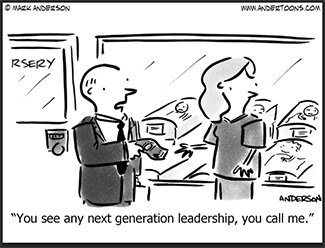 Too few family businesses survive into the second and third generations of ownership. The reason is most often poor communication between family members. Current owners should take steps to strengthen their family dynamics and assure that damaging emotions do not scuttle the enterprise when it comes time to hand over the reins of control.
Too few family businesses survive into the second and third generations of ownership. The reason is most often poor communication between family members. Current owners should take steps to strengthen their family dynamics and assure that damaging emotions do not scuttle the enterprise when it comes time to hand over the reins of control.
In the best of worlds, a family business would thrive for many generations, providing inspiration and revenue for decades to come. Reality, alas, is usually more somber. [rquotes] ‘Only 30 percent of family businesses survive into a second generation, and only 17 percent into a third,’ [rquotes] says Kathyann Kessler Overbeke, principal of GPS: Generation Planning Strategies, Beachwood, Ohio.
Why? Too often the emotions of family members conflict with the demands of the bottom line. “Family businesses are made up of two complex, overlapping systems,” says Overbeke. “One is family and the other is business. The overriding factor that determines success or failure of a family business is management of that space where the family and the business systems overlap.”
[sidebarright225]
Is Your Family Business Prepared for Transition?
When the time comes for a new generation to take control of your family business, will the process go smoothly? One way to find out is to take this quiz. Take the quiz.
[/sidebarright225]
Worlds in collision
Failure to manage family-business conflicts can lead to disaster. Consider, for example, the damage that results when siblings compete for the position of company president. Aware of the emotional time bombs linked to any decision on succession, the parents often opt to ignore the issue.
[quotes]While members of the senior generation typically hope the problem resolves itself on its own, things often spiral downward.[/quotes] “The children are left wondering and confused,” says Ira Bryck, president of the Family Business Center of Pioneer Valley. Not only do they start taking on unsuitable jobs in the hope of “learning their way the top,” they also continually sabotage one another in power struggles that damage the bottom line.
Similar conflicts abound: A favored son expects to be handed the reins of control; an objective assessment points to a daughter as the most promising heir. [rquotes] One sibling favors an expansion beyond current territory; another sides with parents anxious to preserve wealth for retirement. [/rquotes] A daughter’s spouse expects dividends from an inherited ownership stake; management realizes the funds would better be invested in capital equipment.
Such conflicts are typically left to simmer on the back burner because of the common fear that a business-like negotiation will damage family relationships. “In a family business, inadequate communication is problem one, two and three – all the way to infinity,” says Paul Karofsky, Founder of Transition Consulting Group, Palm Beach Gardens, Florida. “Too often family members fail to talk with one another to understand differing perspectives, desires, and concerns.”
[quotes]When conversations do take place, they are coded in words that cover up personal issues,[/quotes] or are interpreted in unintended ways. “Most failures of understanding in a family business do not arise from bad faith or self-absorption,” says Aron Pervin, managing director of Toronto-based Pervin Family Business Advisors. “They are typically due to defense reactions that cloud people’s understanding. Often what is said is not what is heard because the message hurts.”
Letting conflicts fester puts the business in danger. “Emotions quickly end up driving critical business decisions,” says Pervin. “The enterprise becomes riddled with controlling and enabling behaviors, craziness about who’s best and who’s smarter, and maladaptive communications systems. [quotes]People typically end up with perceptions of injustice,[/quotes] and that leads to a passive-aggressive culture that undermines everything.”
Share your vision
[sidebarright225]
Find Roles for Mom and Dad
A successful transition plan includes an enhanced role for the older generation. Retirement poses challenges of its own for the people and the business. This discusses the things you need to consider in planning for a transition for those who have spent their lives in the business. Find out how to make retirement of family members happy and good for the business too. Read More>>>
[/sidebarright225]
Family businesses can obviate all of the above by establishing a common business vision, says Overbeke. “There needs to be a shared understanding of the purpose of the business, beyond just making money. People who possess a shared vision will be willing to make the necessary trade-offs.”
Overbeke offers one example of a shared vision: We want the business to support the family for several generations. Those who accept that overriding goal must then ask what everyone needs to give up to achieve it. That may well include the ability to take money out of the treasury, for example, when the business cannot afford it. Or giving up an ambition to succeed the presidency when another sibling is better qualified. Or taking steps to secure the senior generation’s retirement while funding the growth of the enterprise.
[quotes] Reaching a common shared vision begins with personal self-assessments. [/quotes] “Each family member should be asked to develop a personal vision,” says Overbeke. “What do they want from the family business and what does the business mean to them?” Once individuals understand themselves they can come together as a group and figure out where they have a shared vision of purpose and future for the family business. Then they have a framework for making decisions.
Enter stakeholders
The comments above have concentrated on family members and their psychology. [quotes]The fact is, though, that no family business exists untethered to third parties.[/quotes] “Consideration has to be given to not just family members but all stakeholders,” says Karofsky. “That means in-laws, bankers, suppliers, customers, and the cadre of non-family employees who are impacted by any business decision.”
For all of these stakeholders, decisions touching on the professional advancement of the younger generation can have profound effects. “If the suppliers to the business aren’t enamored with the new management, they may pull their distribution franchises,” says Karofsky. “Suppliers want sustainability. It is vital to them.”
[quotes]Customers will also have a stake in the new management.[/quotes] “So much of business is still done on the basis of relationships,” says Karofsky. “If the members of the second generation are seen as arrogant, entitled brats, customers will go elsewhere.”
Bankers, for their part, will be looking for attractive partners. “The relationship with dad may well have made possible a vital business note or line of credit,” says Karofsky. “If the banker is not enamored of the succeeding generation, the loan might be pulled, and that might be the end of the business.”
These comments suggest that the family business exists as part of a fabric that includes third parties beyond the bloodline. Those parties need to be brought into the decision-making about the future of the business. And they need to accept the validity of the new people assigned to ownership and management positions.
Transition, not succession
[rquotes] What if the next generation lacks the personal and technical skills required to take the family business reins? [/rquotes] In such cases it may be wiser to hire non-family individuals for top management positions, while the second generation retains ownership. “The wisest arrangement may be to keep the business in the family and have outsiders run it,” says Pervin.
While taking on non-family management may be emotionally challenging for the family, it is one more example of the benefits to be gained from skillful management of the interface between the enterprise’s family and business systems.
Even here, adds Pervin, the family members must have ownership skills. “That means people who can make decisions, who understand planning, strategy, finance, organization, and risk management.”
In brief, Pervin suggests suspending the view of the business as a family enterprise and looking at the assets through an owner’s lens. “People want to transfer the business to the next generation for many reasons, and not necessarily the right ones,” he says. “I believe in continuity planning, a process of figuring out the next best thing to do with the business assets.”
Filling the gap
It may well be unclear if the second generation is capable of taking on the reins of management, or if they might be able to do the job with some additional education. [quotes]In such cases, non-family individuals can be brought in for a length of time.[/quotes] “Interim managers can work if there’s a good match between them and those they are mentoring,” says Bryck. A non-family person might well run the business for 10 or 15 years while mentoring the younger people.
One caution: “It’s also important that the personality of the non-family leader be compatible with the culture of the family,” says Karofsky. It’s best to proceed slowly, introducing the proposed manager to all of the affected parties. Does the prospective manager understand, and buy into, the vision shared by the family members?
[rquotes] A second caution: [/rquotes] “It’s also critical that the non-family leader understand the politics of a family business to avoid having people play against one another,” says Karofsky. “You can’t have one sibling cozying up to the interim president, for example, in the process creating conflict with others.”
Start early
[quotes]Of all the forces that threaten the future of the family enterprise, procrastination is perhaps the most insidious.[/quotes] The job of transition is complex, and filled with many tasks and emotions.
“The company needs to devote adequate time to position the next generation,” says Bryck. “That process includes getting family members to grow from operational jobs to leadership positions, assuming they are capable.”
Time must also be sufficient to recruit where necessary, to assess candidates, to create professional development plans, and to help the senior generation move to roles of significance. “The transition needs to be an exceedingly cautious, well played out scenario,” says Karofsky. “The chances of surviving are greatly enhanced when planning is done sufficiently in advance.”
Given sufficient time and dedication, you can assure your family enterprise stays afloat when it’s passed to a new generation. Above all, the communication gaps and unstated emotional conflicts need to be resolved in a way that recognizes the fraught interface of family and business systems.
“The biggest reasons for the failure of family businesses are poor leadership, unresolved conflicts, and the inability to agree on goals and share a vision,” says Karofsky. “That was true in years past and it remains true today.”














